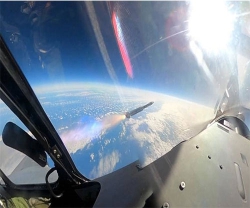At the upcoming Paris Air Show, which runs from 19th to 25th June 2017, Airbus will showcase its wide range of innovative technologies, products and services, from market-leading commercial and military aircraft to helicopters and space systems. In addition, there will be a new Digital Exhibition zone at the Airbus pavilion (located at the end of Chalet Row A), where traditional mock-ups give way to the latest digital immersive and interactive display technologies to convey an improved experience of Airbus’ products and services, in life-like virtual reality scenarios.
In the static display areas, visitors will see a plethora of Airbus’ real operational and development aircraft. Notably, this year’s show will be the first time that Airbus showcases publicly in the flying display its new A321neo and also the latest member of the A350 XWB family - the A350-1000. Both of these new models are currently well into their certification flight testing phases. The flagship A380 will also feature in both the static and flying displays.
Meanwhile, Airbus Defence and Space’s exhibits will include the A400M, the C295 and the Eurofighter Typhoon. At the other end of the size scale, but every bit as cutting-edge, will be a collection of unmanned air systems including the “Harfang”, the DVF 2000 VT Aliaca, the DVF 2000 ER Arrano, and the Quadcruiser. In the space perimeter will be a comprehensive portfolio of satellites, highlighting recent successes such as the first all-electric satellite in the three-tonne class, EUTELSAT 172B, or PerúSAT-1, which was delivered in only 24 months and hence set a new benchmark in terms of delivery time. Guests to the Airbus pavilion will also have the opportunity to experience a virtual reality visit to the International Space Station ISS, and see how with ‘Space Tug’, Airbus is getting ready to revolutionise the space business through ‘on-orbit’ services.
Airbus Helicopters’ line-up on the static display includes the H130, the H135 equipped with the Helionix digital avionics suit, the H145M fitted out with HForce and a Tiger helicopter from the French army which will also perform flight demos during the show. Show-goers will be able to discover at first-hand Airbus Helicopters’ innovative solutions for preparing the future of vertical take-off and landing (VTOL) with a mock-up of its new high-speed demonstrator at the Clean Sky booth. The future of unmanned flight is a key element in development with, on the military side, the VSR700 mock-up on the static display, and on the civil side a mock-up of CityAirbus, the “urban air mobility” solution for congested cities, at the Paris Air Lab booth.
As well as exploring all this latest hardware ‘up close’, or from afar as they perform their impressive air displays, visitors to Airbus’ new “Digital Exhibition” concept area will be able to interactively immerse themselves in the fine details of every facet in Airbus’ group-wide activities - spanning not only Commercial Aircraft, Defence and Space, Helicopters, Services, but also other areas such as future research, the extended innovation ecosystem, electrification, “urban air mobility”, the Airbus Foundation as well as its workforce diversity.
Moreover, with special VR headsets, guests will be able to fly-through the International Space Station, experience a H175 helicopter search-and-rescue mission, sit inside the cockpit of an A400M as it takes off from rough terrain, or explore the latest “Airspace” cabin interior innovations. In addition to hosting these immersive VR scenarios, the Exhibition will also feature a unique “HoloLens” zone which projects dynamic 3D holographic models - such as the ‘ExoMars’ Rover traversing a Martian landscape.
Airbus, which plans to recruit nearly 3,000 people in 2017, will be present throughout the week at the “Avion des Métiers” and “Forum Emploi Formation” areas dedicated to careers, training and employment in the aerospace industry. Airbus will also demonstrate its commitment to diversity and inclusion in the industry through meetings and conferences.
In addition, the company will formalise several partnerships with research centres, schools and universities to ensure that in the coming years, industrial and academic requirements converge, and provide the skills which it needs to continuously innovate.





















